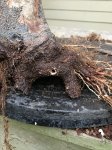markyscott
Imperial Masterpiece
Cover over the whole thing with cut paste. The main thing you're trying to avoid is water getting inside the graft union. That can interfere with the callousing and increase the chance of failure. So be conscious of this when you're applying the cut paste and ensure a good seal where water may be running down the trunk and can enter the wound.


By the way, Danny Coffey visited Houston not too long ago and left us with a great tip about cut paste. See this stuff?

At $14 for the little cup it's darn expensive. See this stuff?

At $18 for 5 lbs is darn cheap and you can pick it up at Home Depot. Not Loews, weirdly enough (at least the one by my house). According to Danny, the difference is Neem oil. Work it into the duct seal until it's as pliable as you like and then store it in a plastic bag.


By the way, Danny Coffey visited Houston not too long ago and left us with a great tip about cut paste. See this stuff?

At $14 for the little cup it's darn expensive. See this stuff?

At $18 for 5 lbs is darn cheap and you can pick it up at Home Depot. Not Loews, weirdly enough (at least the one by my house). According to Danny, the difference is Neem oil. Work it into the duct seal until it's as pliable as you like and then store it in a plastic bag.





















